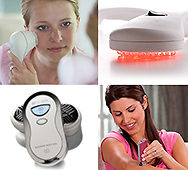Nearly 70% of the respondents from the newest consumer research, which queries women from China, France, Germany, Japan, the United Kingdom, and the United States that own devices for aesthetic benefits are either “satisfied” or “very satisfied” with these high-tech gadgets, according to our recently published Beauty Devices: Global Market Brief. Meanwhile, awareness is low with “didn’t know about them” as the second most commonly given reason from those who have not yet tried an at-home beauty device.
“Our research shows that women who use skin care devices have a high level of satisfaction. However, the penetration rates of these high-tech gadgets are low across most regions due to lack of awareness about them, indicating significant opportunity for marketers to attract new consumers,” notes Karen Doskow, Director of Consumer Products at Kline.
Penetration rates of device usage are low across all surveyed countries except for China, which indexed well above the average at 60%. Usage was particularly low in Japan and the United Kingdom for cleansing devices, the leading beauty device used by those surveyed. Lack of knowledge about these products is among the key factors for limited use. The challenge for marketers of at-home skin care devices is to introduce and educate consumers to the merits of devices. “Building greater awareness of device benefits and growing consumer confidence in the efficacy and value of devices is essential for market growth,” suggests Doskow. “Leveraging the satisfied customers and getting them to talk about devices within their social circles could be a key factor for success,” she continues.
The high penetration rate in China solidifies the country’s status as a beauty mecca and hotbed of opportunity for marketers of beauty devices and topical skin care products alike. Global brands such as L’Oréal’s Clarisonic and Nu Skin’s Galvanic Spa continue to infiltrate the Asian market, placing more pressure on regional and local players with their dominant product portfolios and strong marketing activities. However, a few leading local players, such as Talika and SKG, are forecast to perform positively through 2018.
The level of dissatisfaction with topical products is also indicating significant market potential for devices. More than half of those surveyed agreed that there is only so much that topical products can do to fight aging and acne.
Another salient research finding is that the greatest incentive to try an at-home device is by receiving it as a gift, signaling a huge opportunity for positioning at-home devices with increased marketing efforts during the prime gift-giving holidays.
Globally, the at-home beauty devices market grows by nearly 20% in 2013. While the United States continues to grow at a moderate pace, the focus is shifting to Asian markets geared up by increasing competition from the global brands, such as Clarisonic, Silk’n, TRIA, and Galvanic Spa. Clarisonic is the clear-cut market leader globally; moreover, it is the only brand to have usage by 50% or more of cleansing device users in all countries examined.
It is important to understand what types of devices are popular and how leading brands are positioned across various regions. Kline’s Beauty Devices: Global Market Brief enables subscribers to identify business opportunities by analyzing the dynamics in one of the most important markets of the personal care industry offering a robust analysis of the global market for at-home skin care devices focusing on key trends, developments, and business opportunities in thriving consumer markets around the world.

